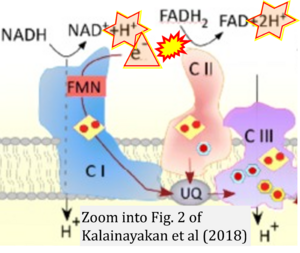Kalainayakan 2018 Cell Biosci
| Kalainayakan SP, FitzGerald KE, Konduri PC, Vidal C, Zhang L (2018) Essential roles of mitochondrial and heme function in lung cancer bioenergetics and tumorigenesis. Cell Biosci 8:56. https://doi.org/10.1186/s13578-018-0257-8 |
Kalainayakan SP, FitzGerald KE, Konduri PC, Vidal C, Zhang L (2018) Cell Biosci
Abstract: Contrary to Warburg's hypothesis, mitochondrial oxidative phosphorylation (OXPHOS) contributes significantly to fueling cancer cells. Several recent studies have demonstrated that radiotherapy-resistant and chemotherapy-resistant cancer cells depend on OXPHOS for survival and progression. Several cancers exhibit an increased risk in association with heme intake. Mitochondria are widely known to carry out oxidative phosphorylation. In addition, mitochondria are also involved in heme synthesis. Heme serves as a prosthetic group for several proteins that constitute the complexes of mitochondrial electron transport chain. Therefore, heme plays a pivotal role in OXPHOS and oxygen consumption. Further, lung cancer cells exhibit heme accumulation and require heme for proliferation and invasion in vitro. Abnormalities in mitochondrial biogenesis and mutations are implicated in cancer. This review delves into mitochondrial OXPHOS and lesser explored area of heme metabolism in lung cancer.
• Bioblast editor: Gnaiger E
Correction: FADH2 and Complex II
- FADH2 is shown as the substrate feeding electrons into Complex II (CII). This is wrong and requires correction - for details see Gnaiger (2024).
- Gnaiger E (2024) Complex II ambiguities ― FADH2 in the electron transfer system. J Biol Chem 300:105470. https://doi.org/10.1016/j.jbc.2023.105470 - »Bioblast link«
Hydrogen ion ambiguities in the electron transfer system
Communicated by Gnaiger E (2023-10-08) last update 2023-11-10
- Electron (e-) transfer linked to hydrogen ion (hydron; H+) transfer is a fundamental concept in the field of bioenergetics, critical for understanding redox-coupled energy transformations.
- However, the current literature contains inconsistencies regarding H+ formation on the negative side of bioenergetic membranes, such as the matrix side of the mitochondrial inner membrane, when NADH is oxidized during oxidative phosphorylation (OXPHOS). Ambiguities arise when examining the oxidation of NADH by respiratory Complex I or succinate by Complex II.
- Oxidation of NADH or succinate involves a two-electron transfer of 2{H++e-} to FMN or FAD, respectively. Figures indicating a single electron e- transferred from NADH or succinate lack accuracy.
- The oxidized NAD+ is distinguished from NAD indicating nicotinamide adenine dinucleotide independent of oxidation state.
- NADH + H+ → NAD+ +2{H++e-} is the oxidation half-reaction in this H+-linked electron transfer represented as 2{H++e-} (Gnaiger 2023). Putative H+ formation shown as NADH → NAD+ + H+ conflicts with chemiosmotic coupling stoichiometries between H+ translocation across the coupling membrane and electron transfer to oxygen. Ensuring clarity in this complex field is imperative to tackle the apparent ambiguity crisis and prevent confusion, particularly in light of the increasing number of interdisciplinary publications on bioenergetics concerning diagnostic and clinical applications of OXPHOS analysis.
Labels: Pathology: Cancer
Warburg effect




